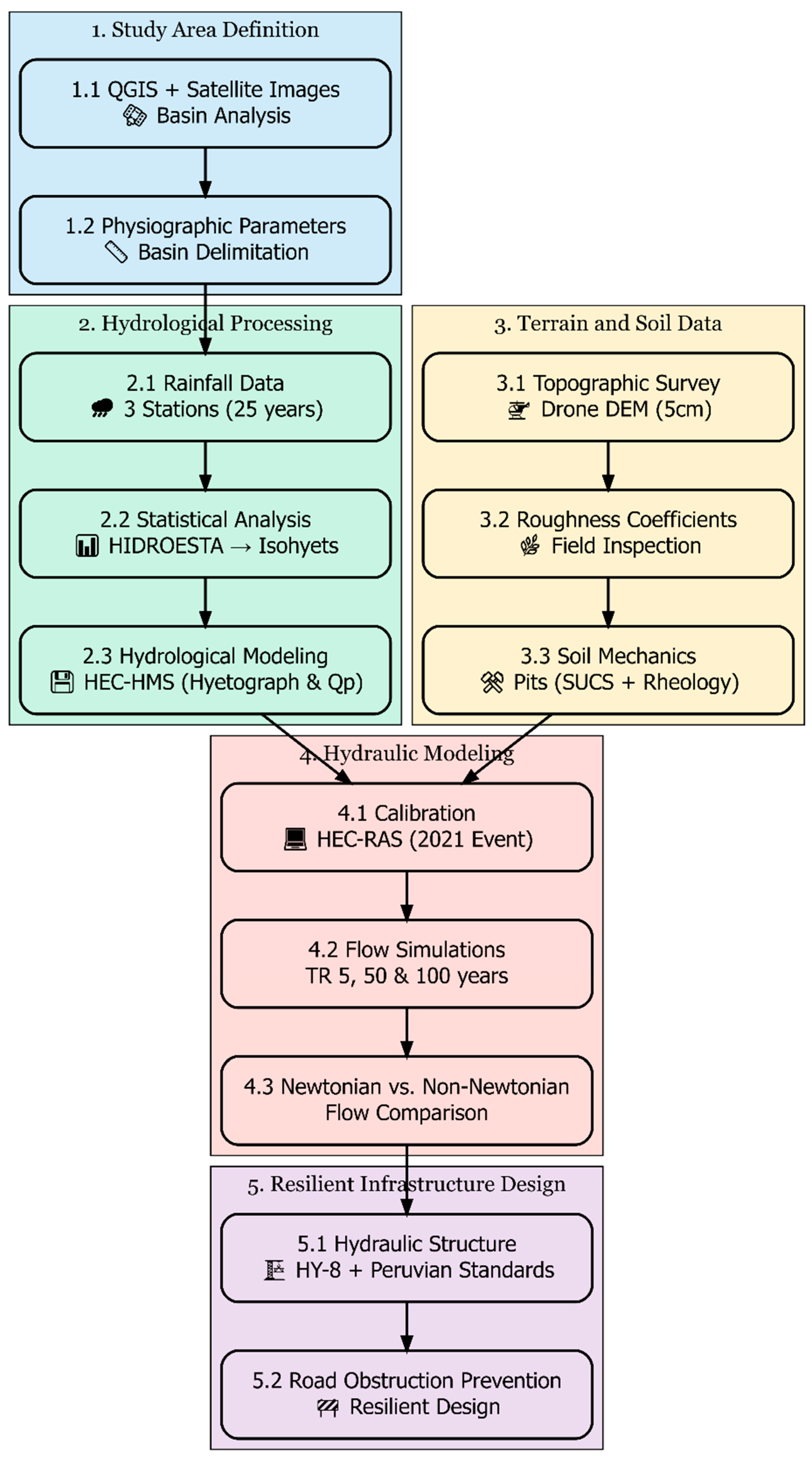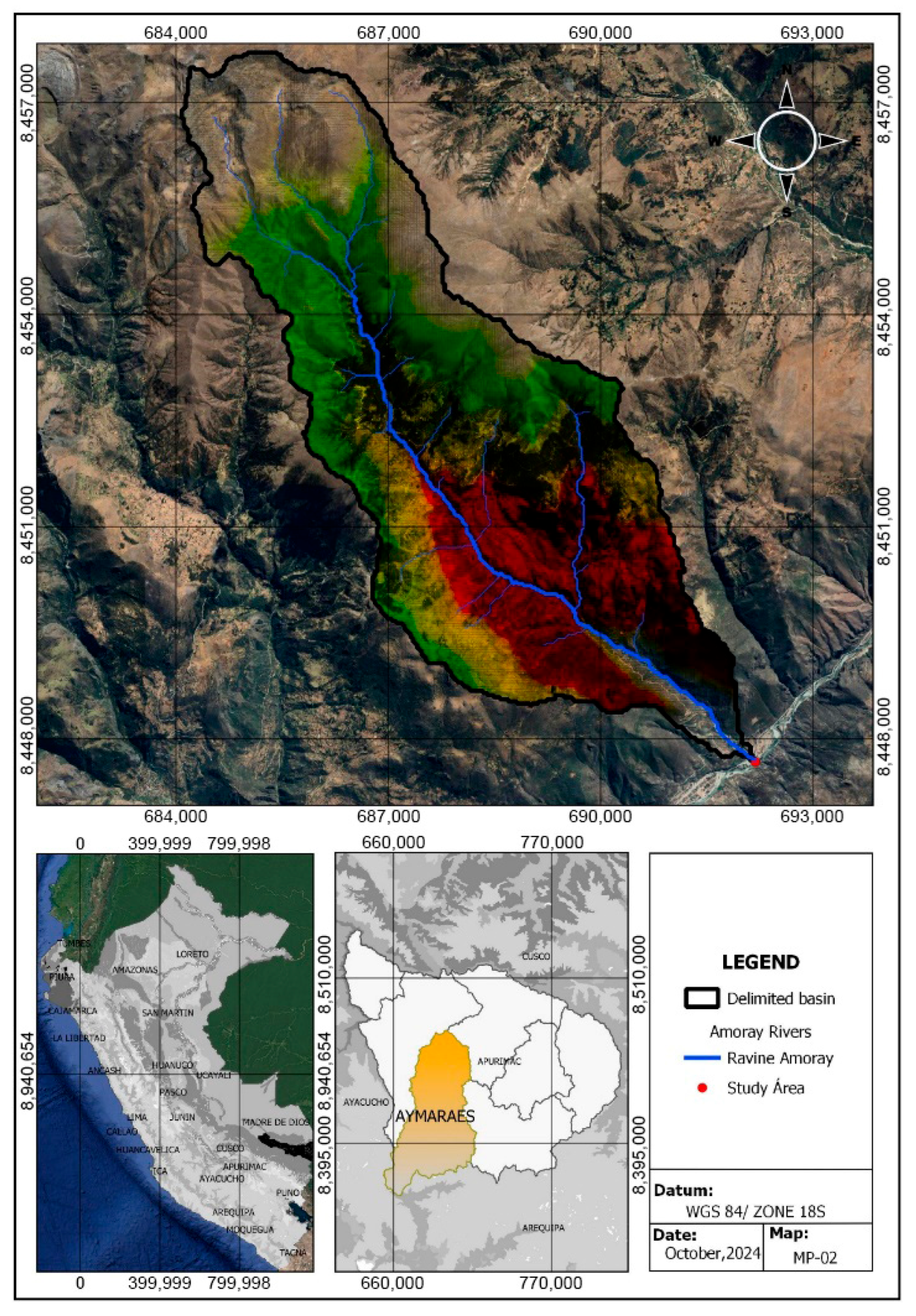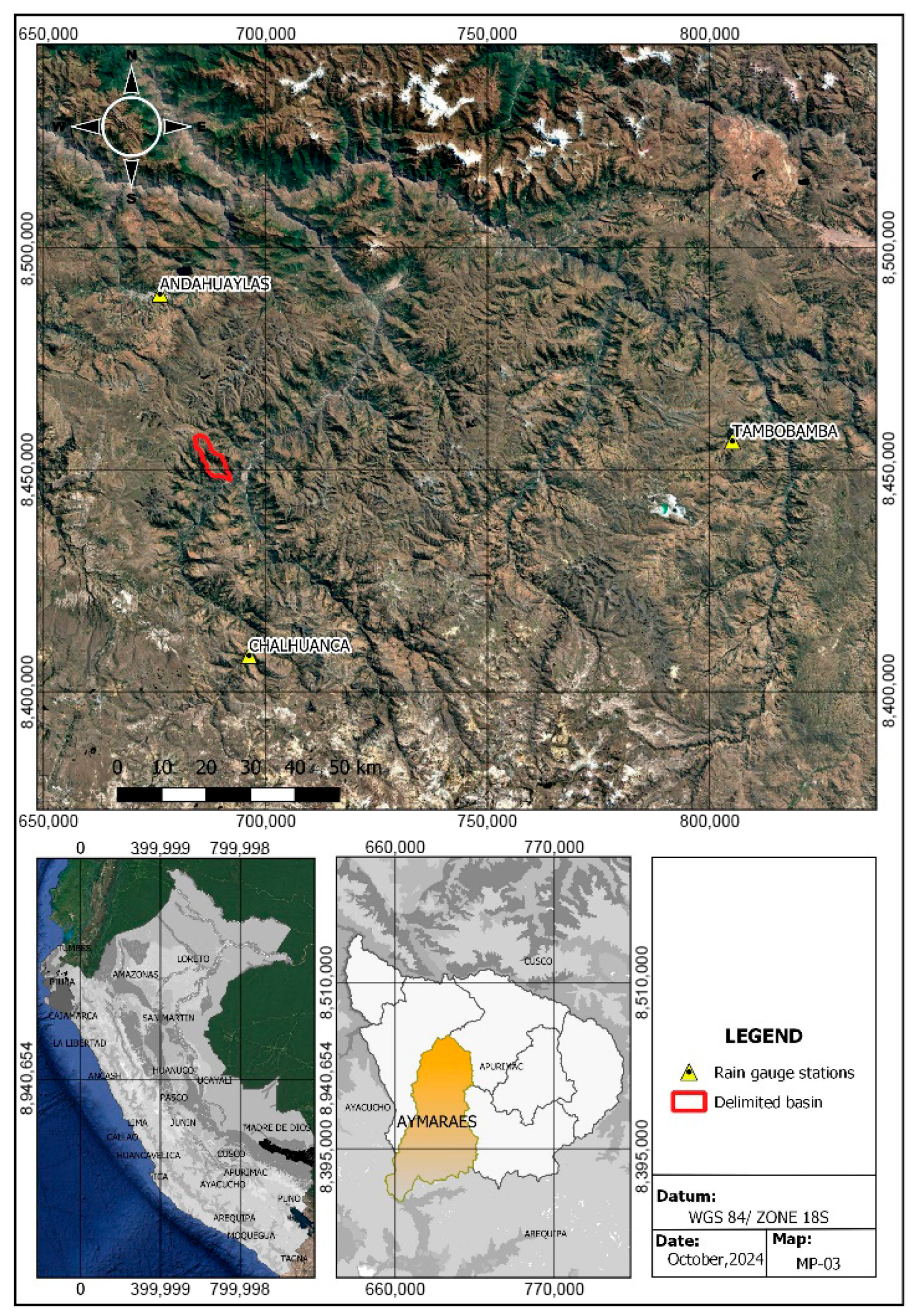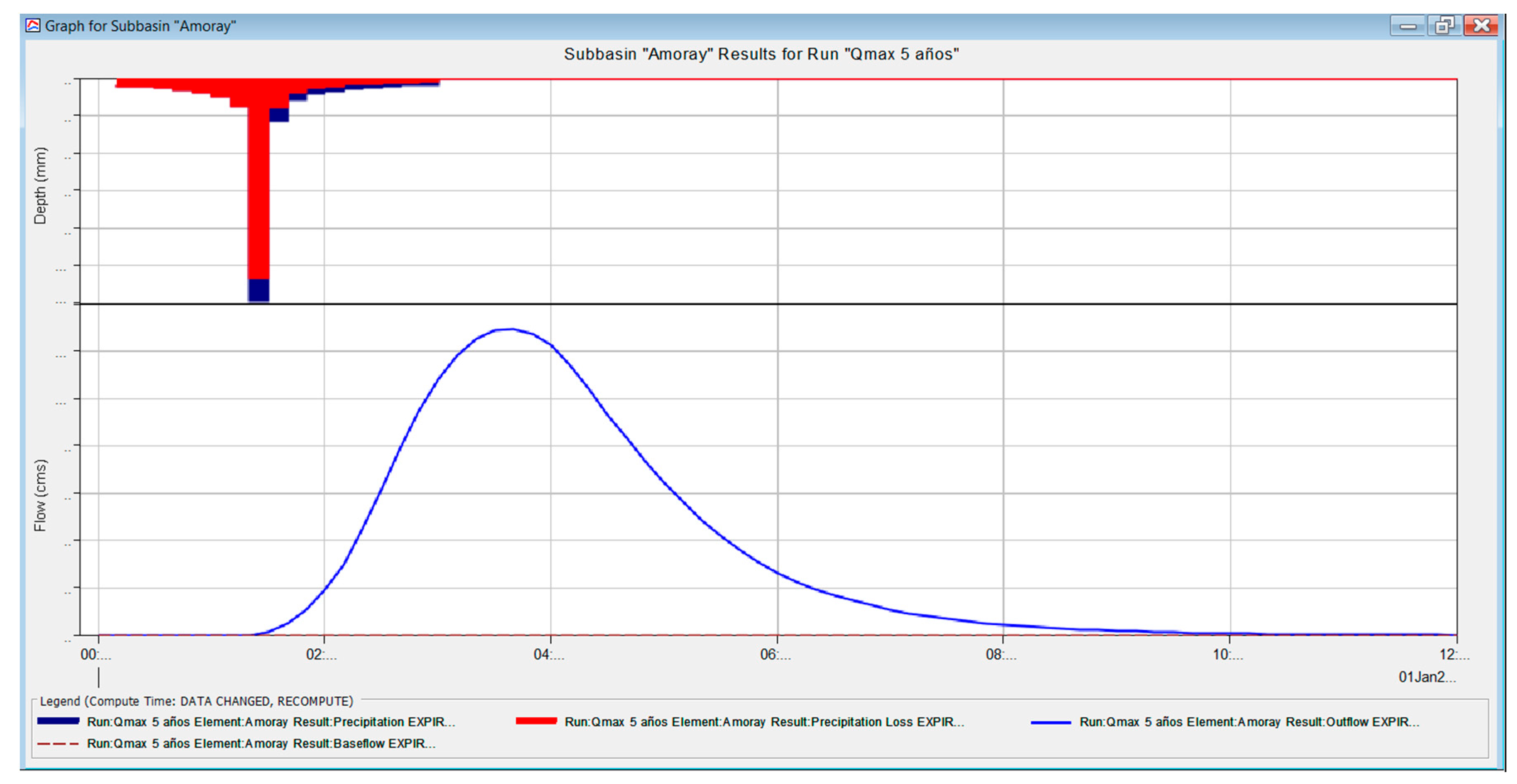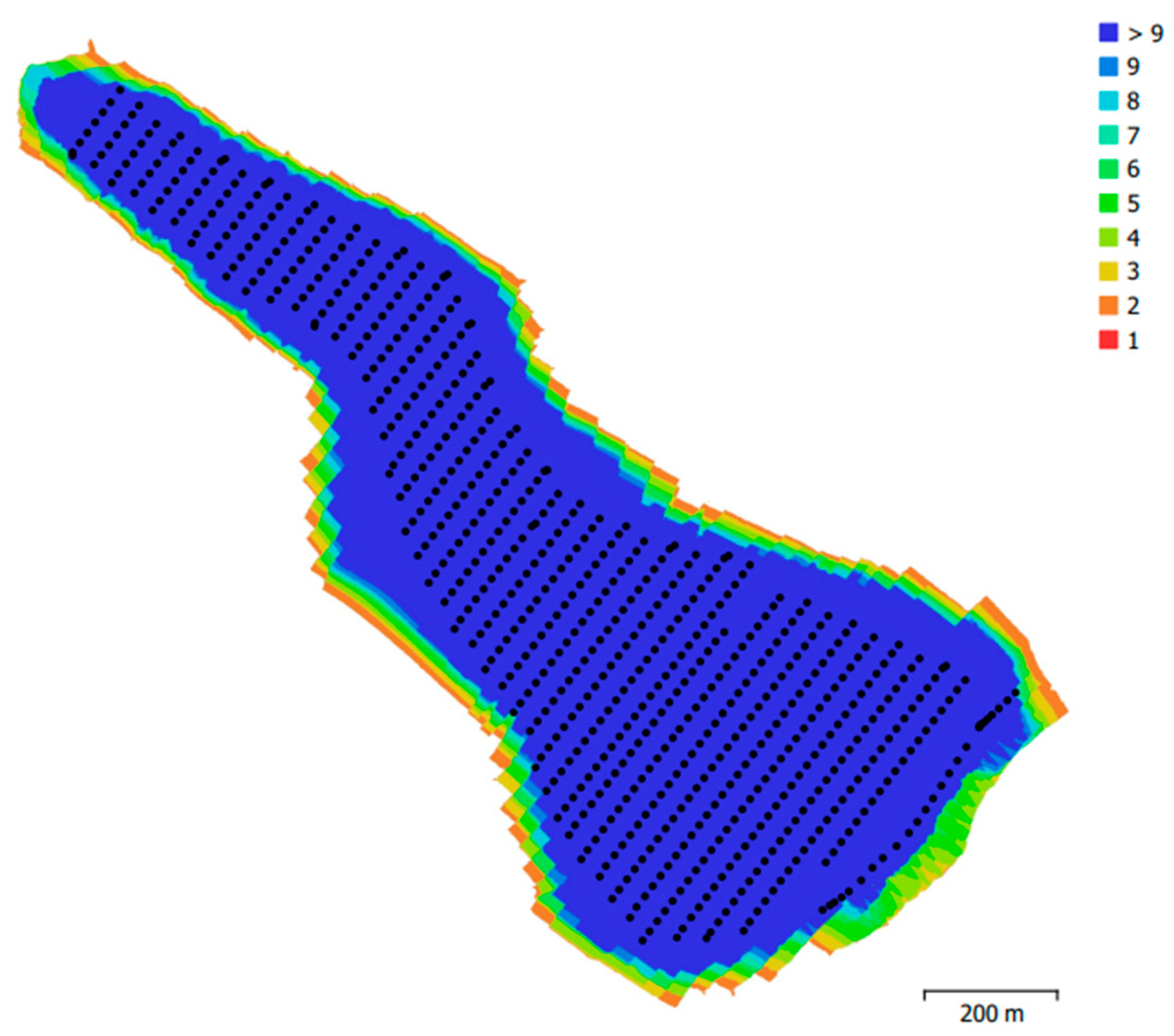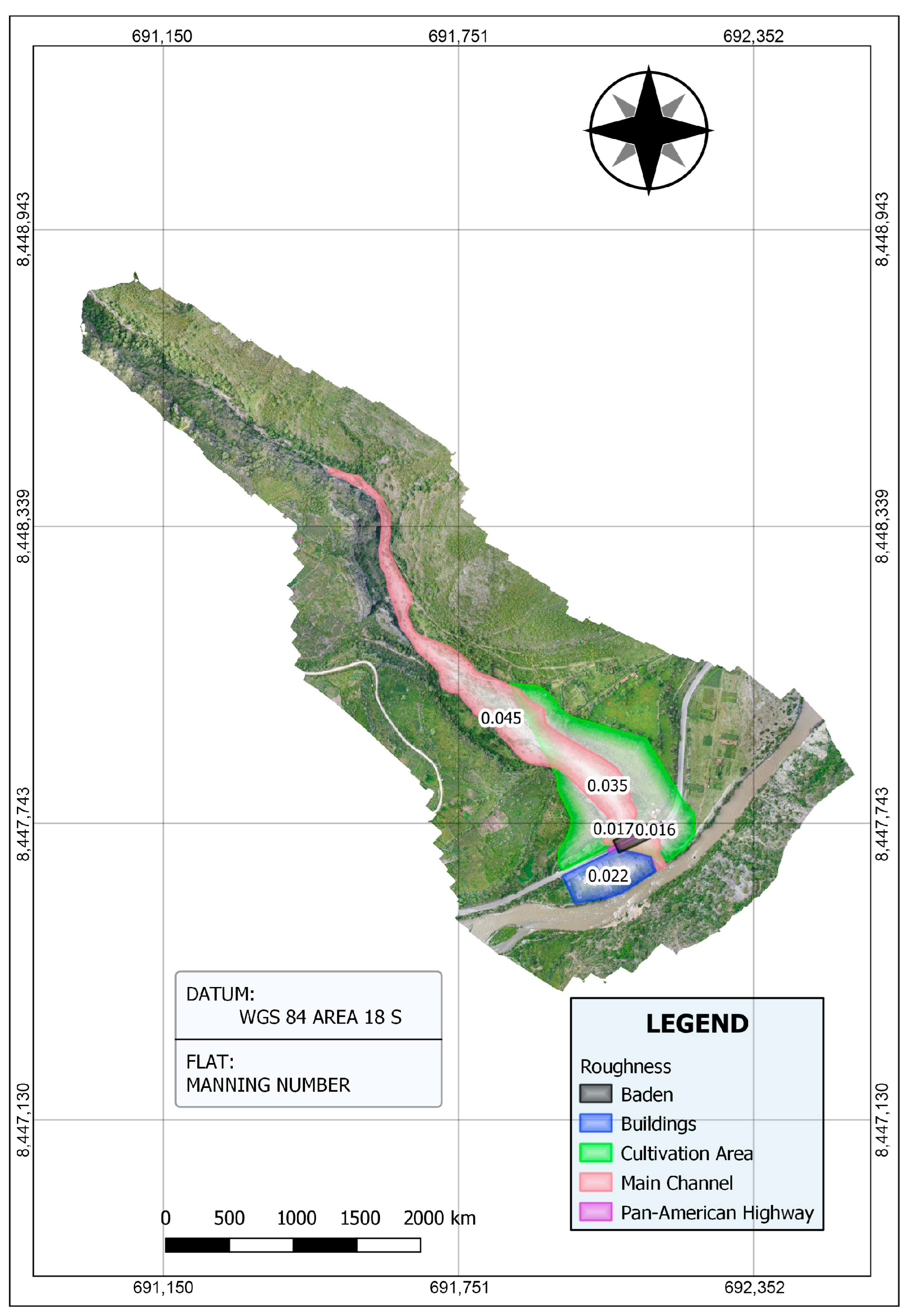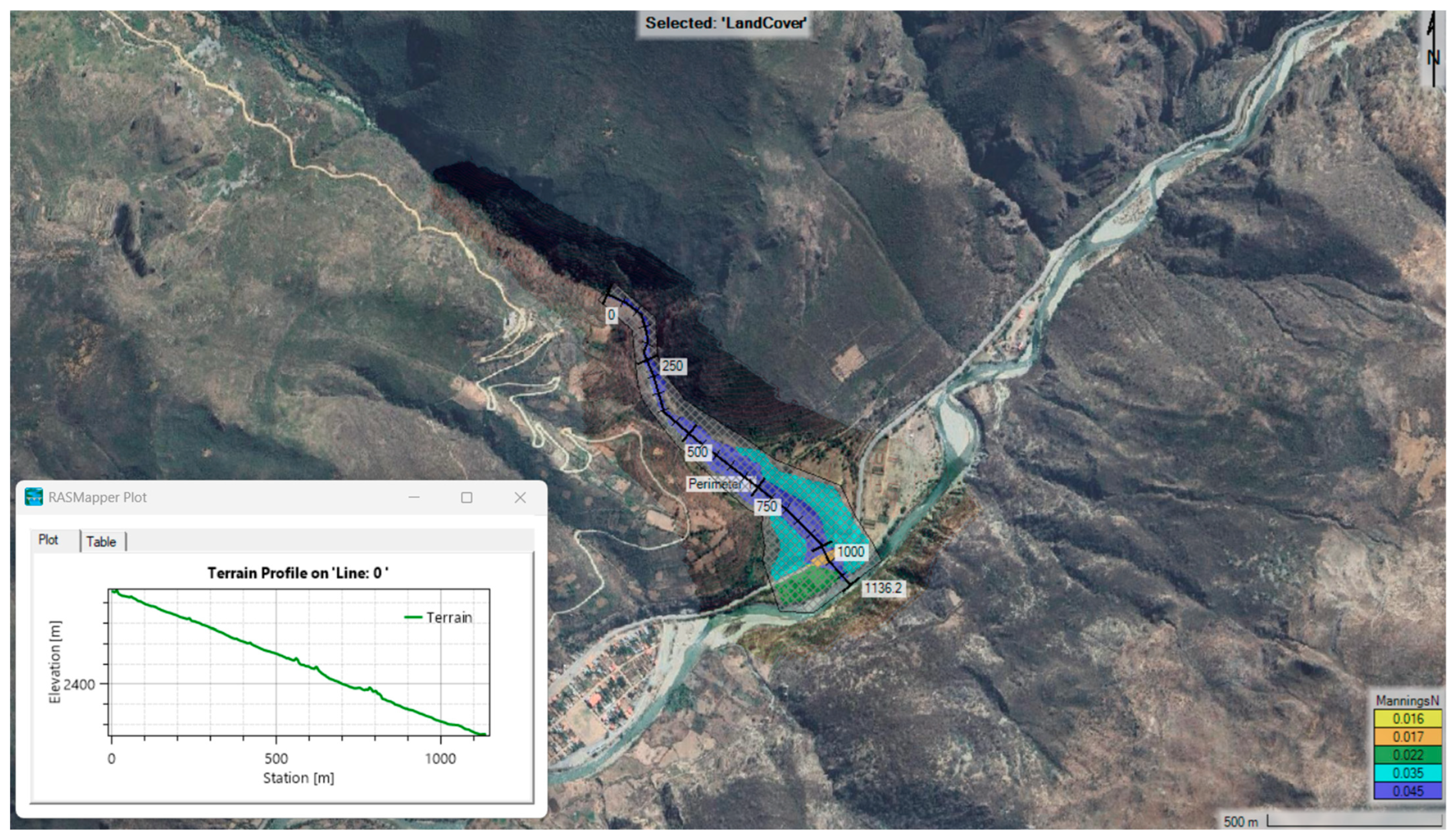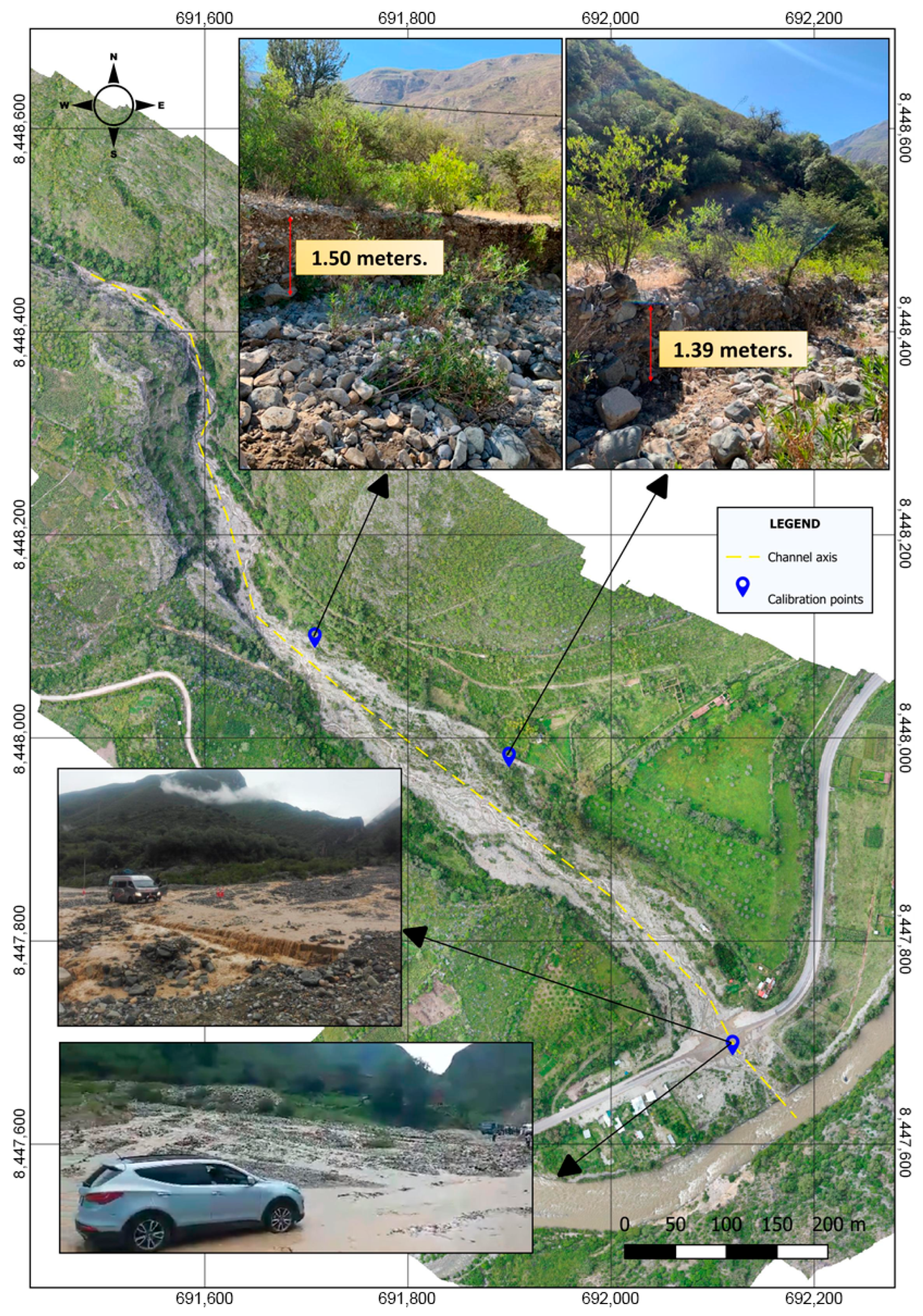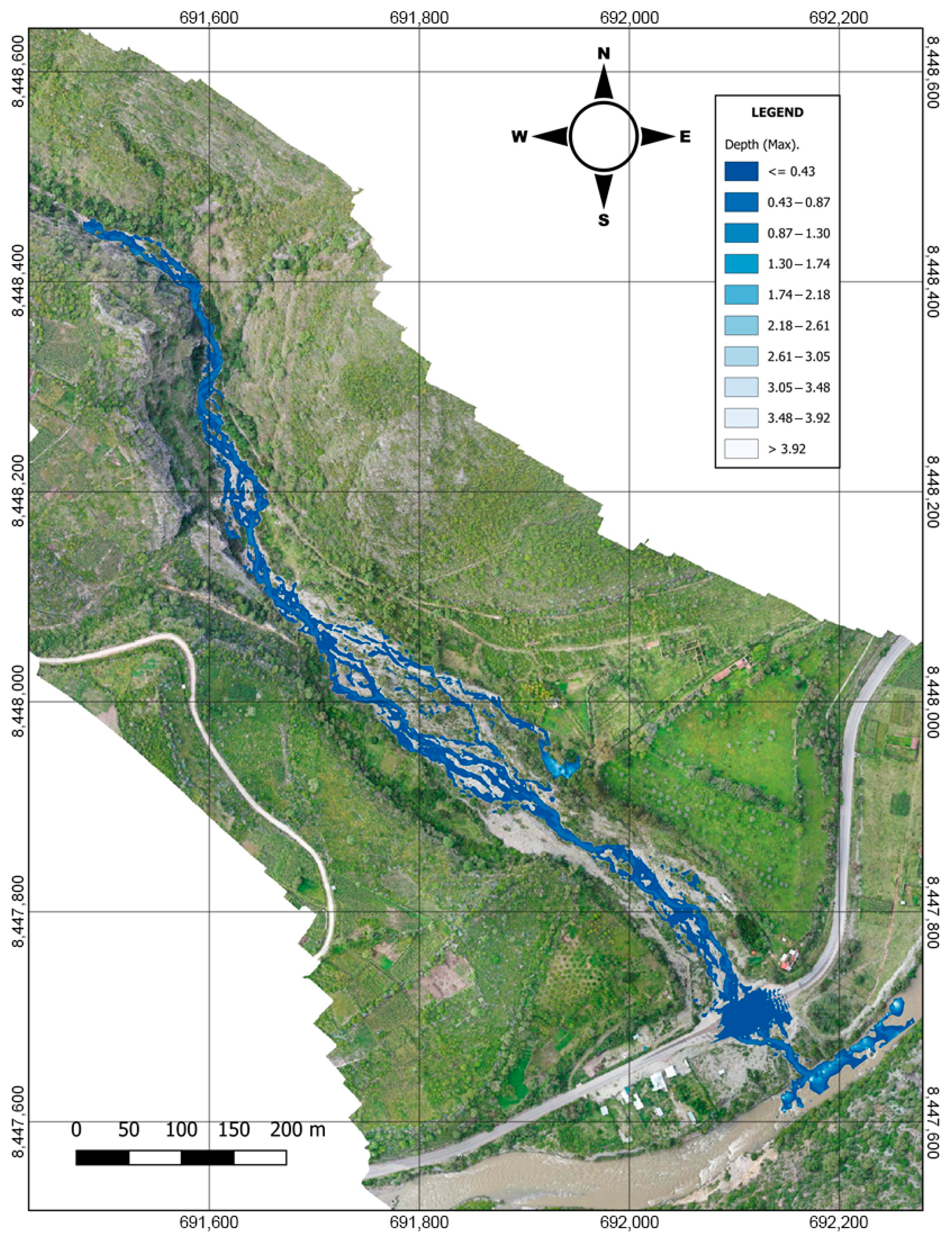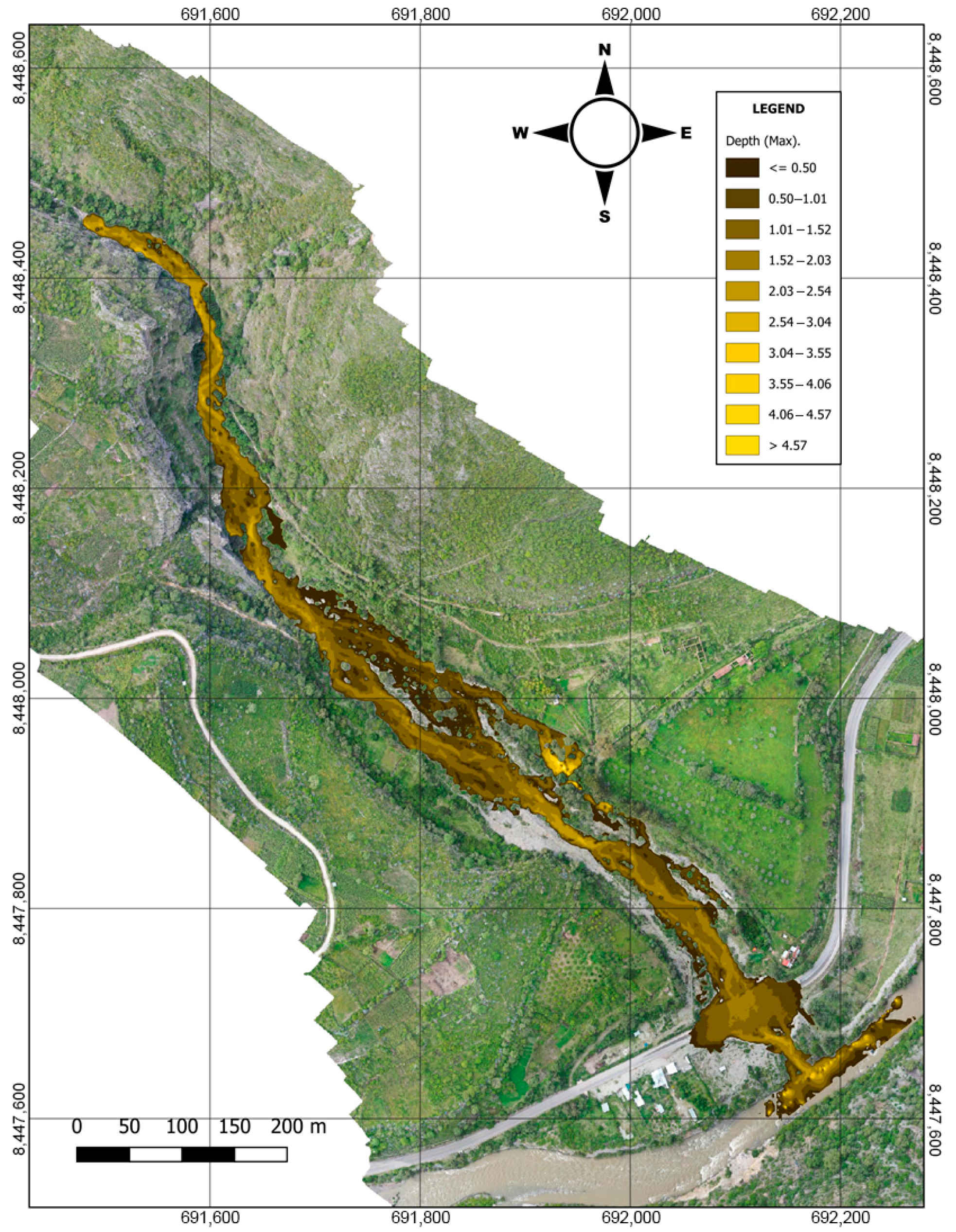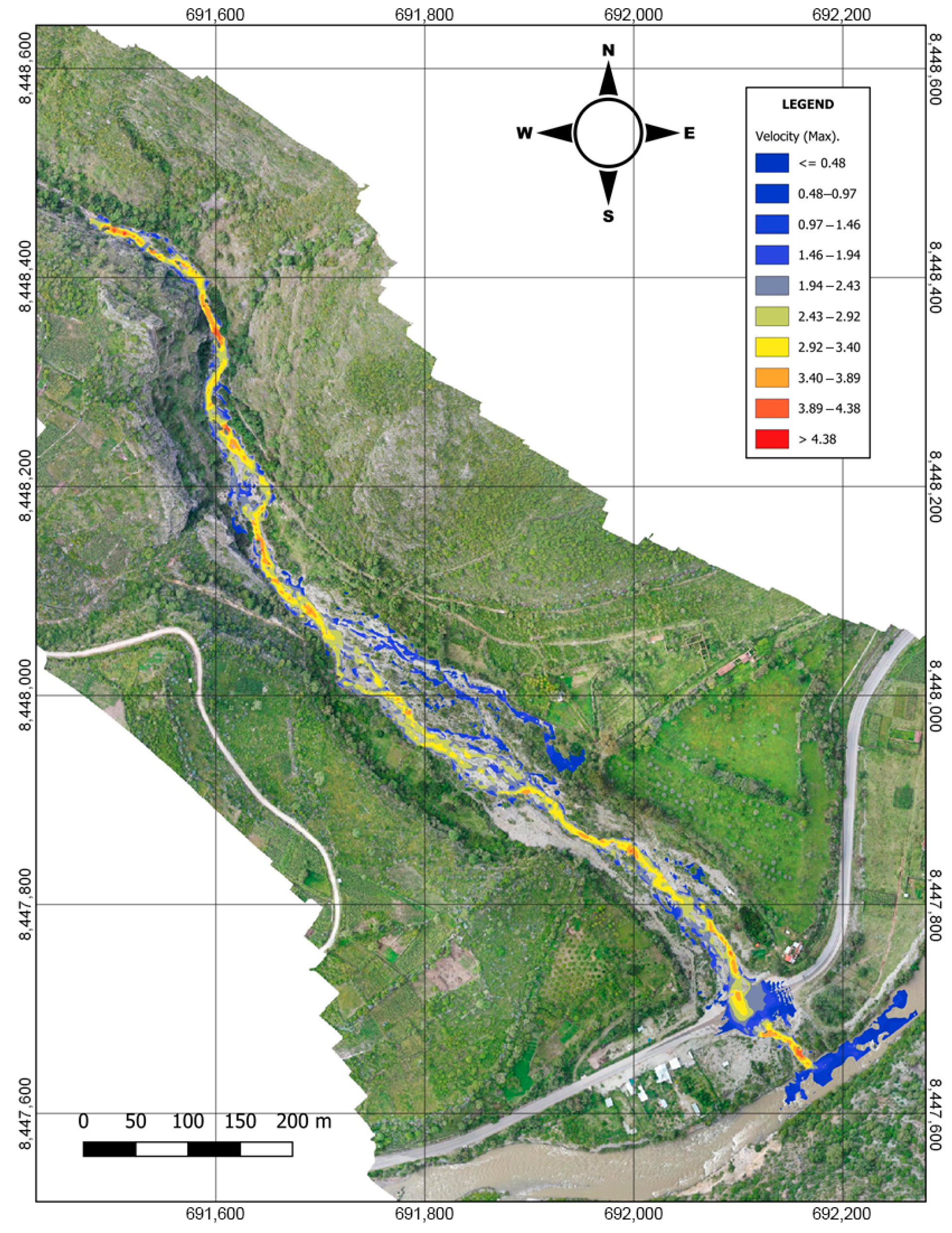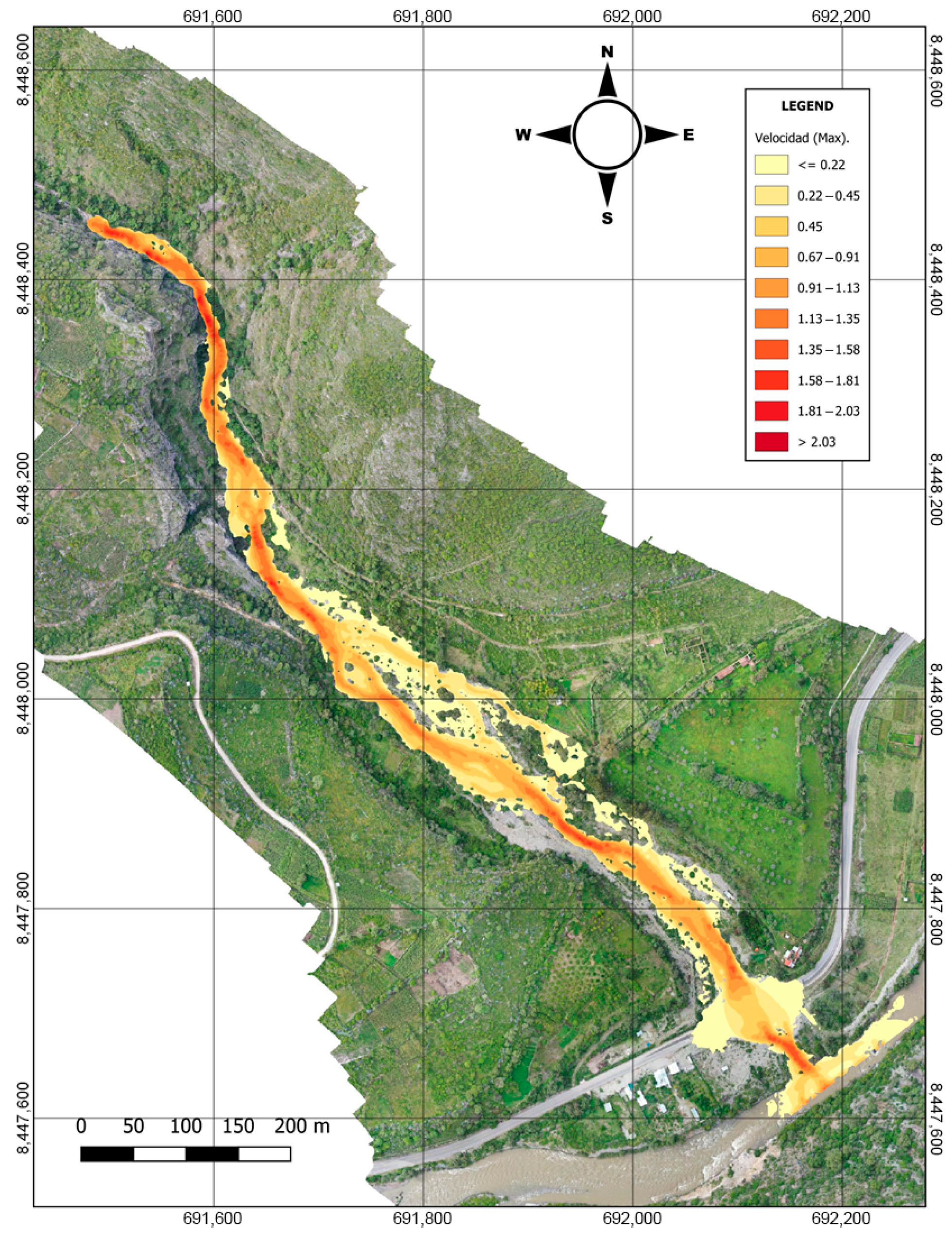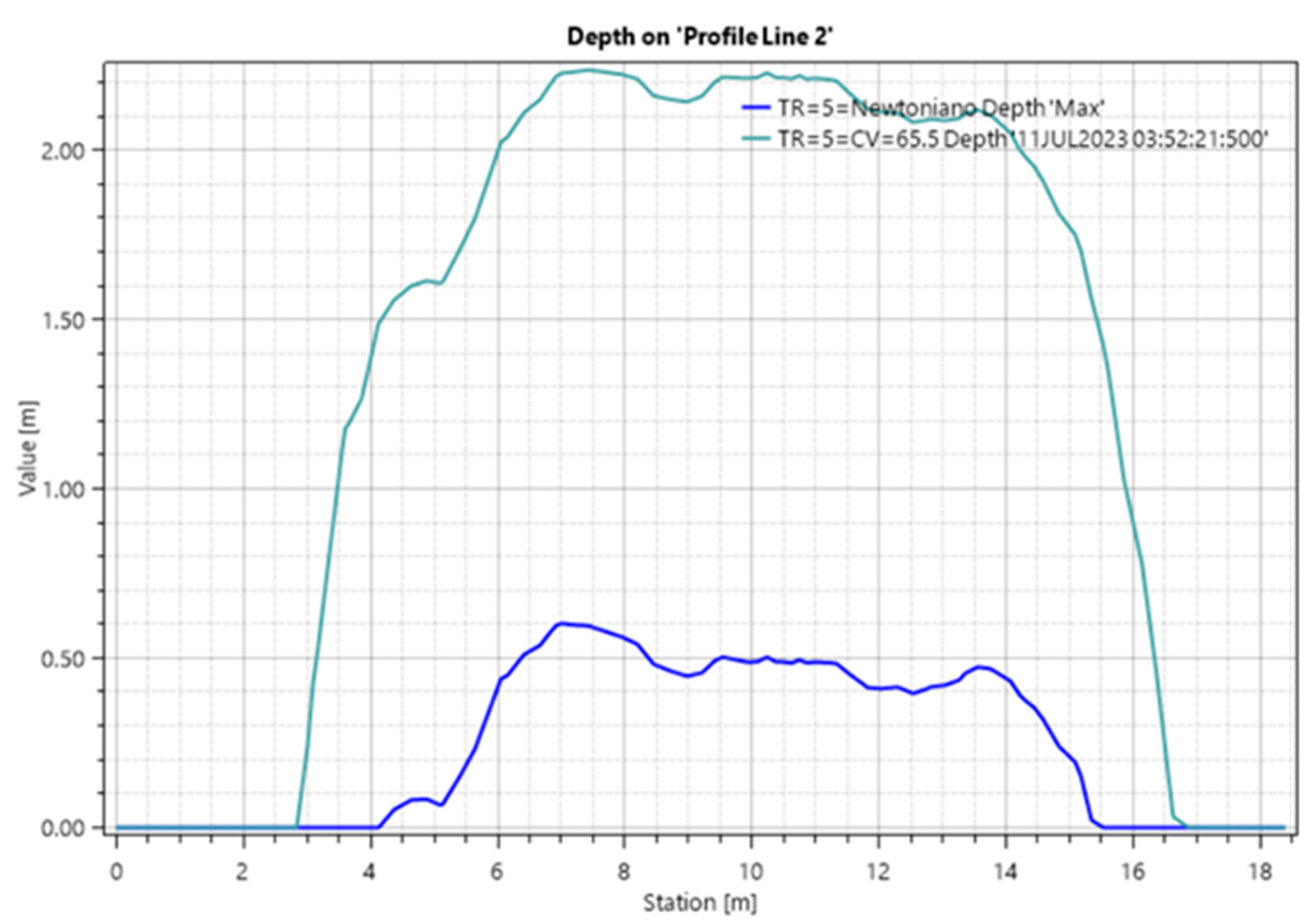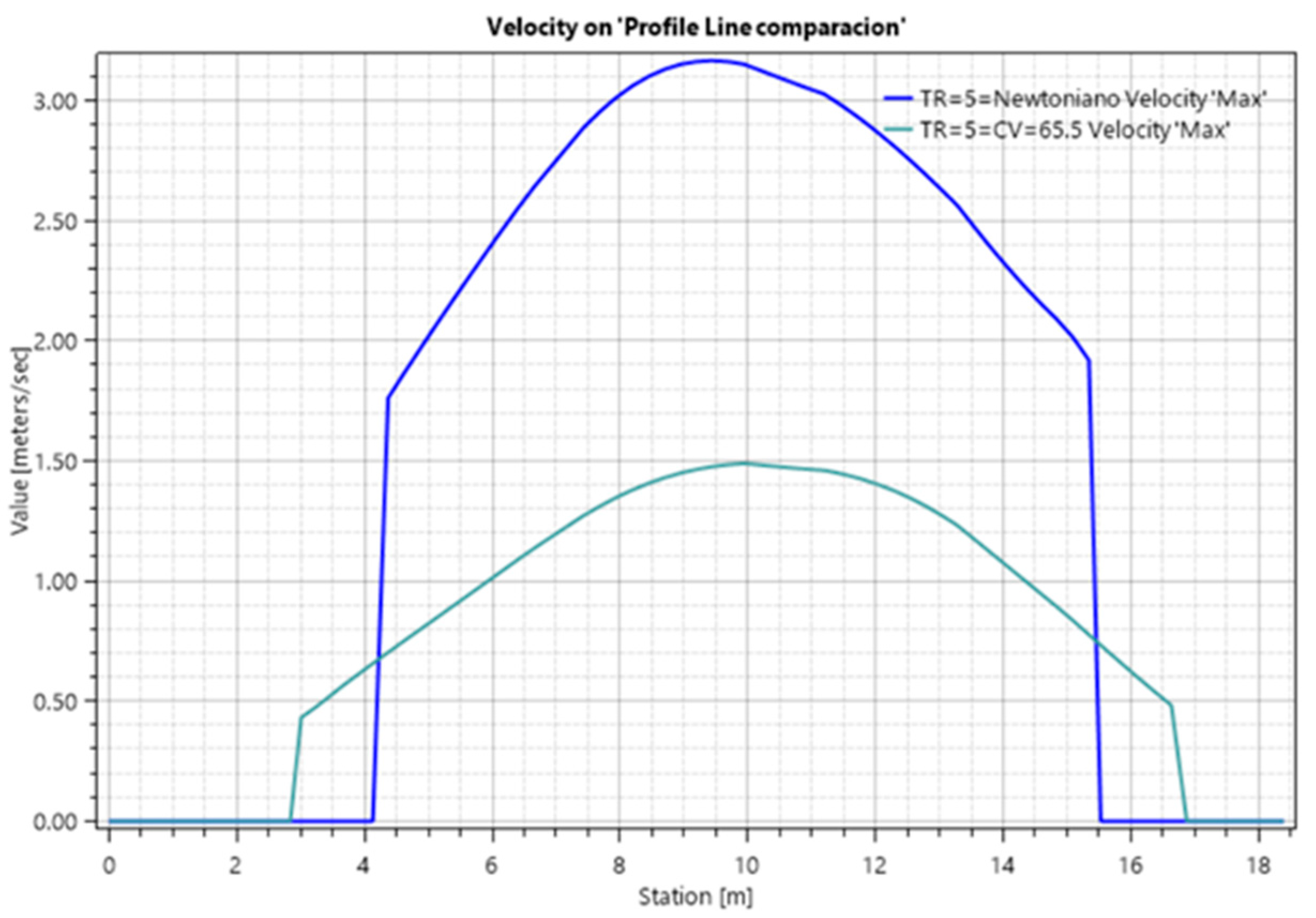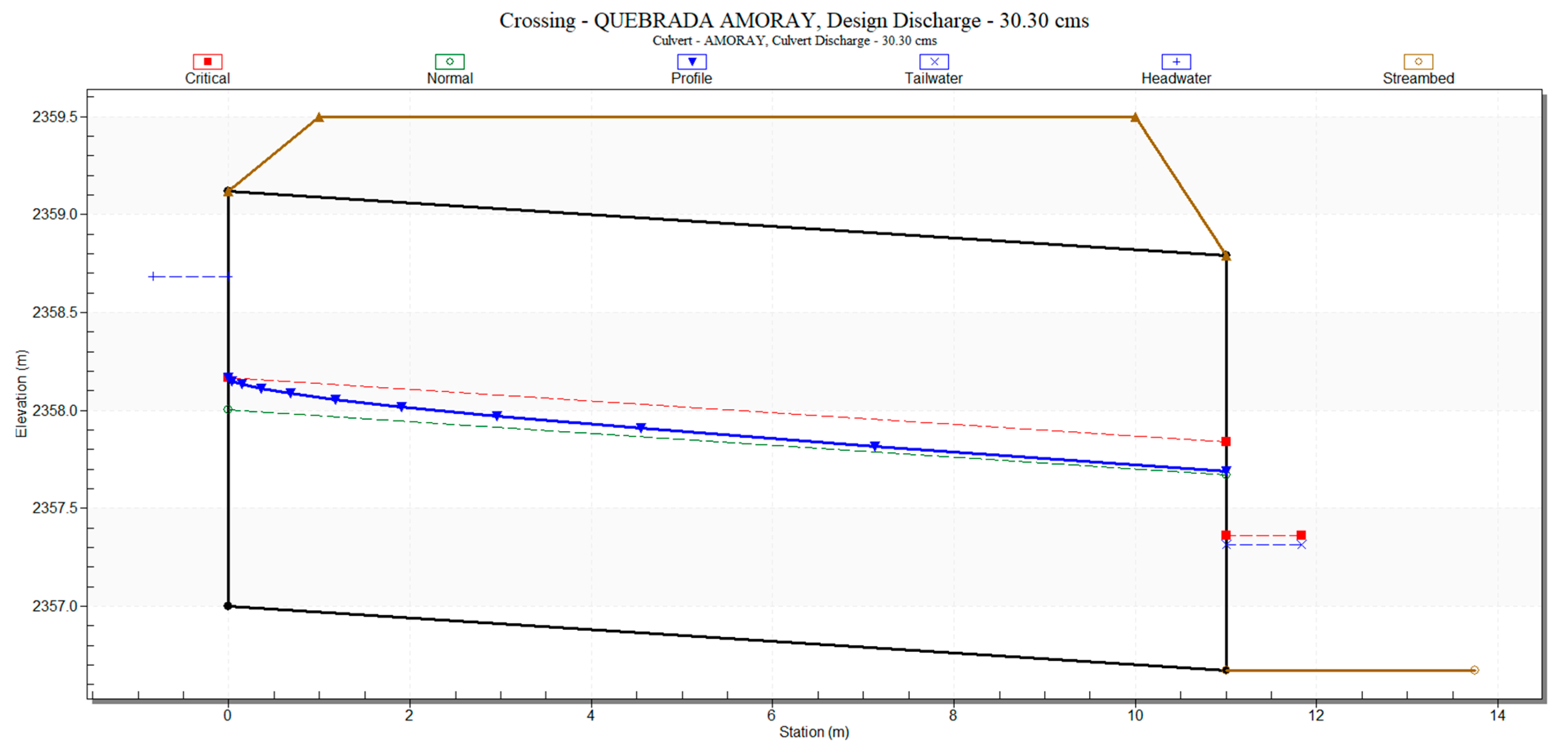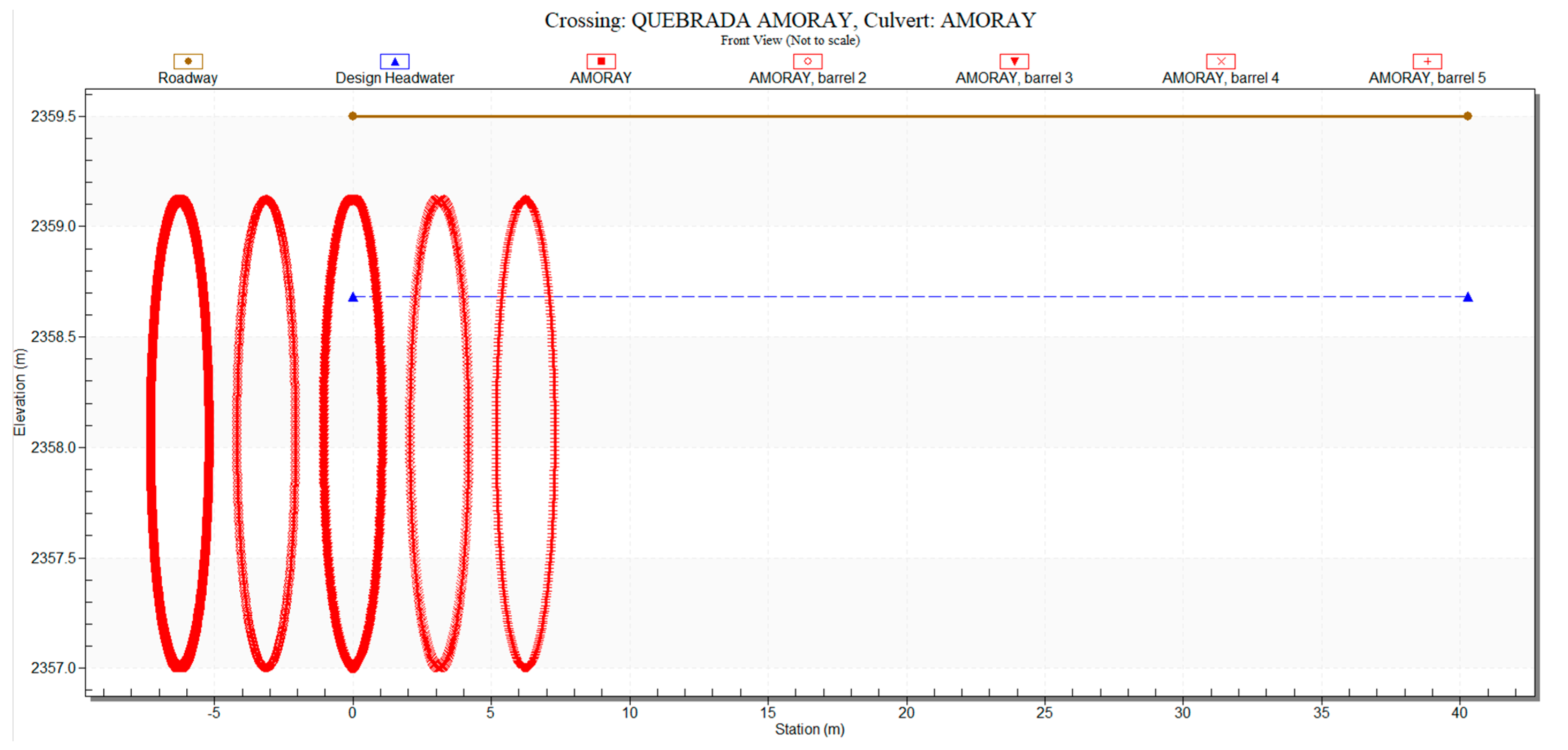1. Introduction
Globally, since the 1980s, there has been a significant surge in research on vulnerability to natural disasters, driven by the growing impacts of climate change. Among these, floods and their effects on transportation infrastructure have garnered particular attention, prompting advancements in resilience engineering [
1]. Resilience emphasizes effective floodwater management, which mitigates risks to both populations and infrastructure [
2]. As climate change has amplified the intensity and frequency of flooding in recent decades [
3], enhancing infrastructure resilience has become a critical priority especially for vital systems like transportation networks, which must remain safe and fully operational [
4]. Flood risk analysis through hydrological modeling and forecasting is critical for assessing flood resilience, as water depth and spatial extent directly determine transportation infrastructure vulnerability [
1]. To improve accuracy, hydraulic simulation tools such as 1D HEC-RAS [
5], 2D Iber [
6,
7], and HEC-RAS 2D [
8], integrated with software like GIS and HEC-HMS, are essential for developing flood risk reduction strategies [
9]. These tools have been extensively applied to critical transportation infrastructure, particularly railway networks [
10] and bridges [
11,
12,
13]. However, significant research gaps remain in modeling debris flow interactions with transportation networks, especially highways traversing alluvial fans where non-Newtonian flows dominate. This research gap is particularly critical in regions like Peru, where such events frequently disrupt vital transport corridors.
Peru is one of the most vulnerable countries to climate change alterations, which produces several natural phenomena, such as floods, that intensify their consequences [
14]. In the 1997–1998 ENSO (El Niño-Southern Oscillation) event, Peru and Ecuador were the most affected countries in South America due to widespread flooding and landslides [
15]. That situation gave the authorities an opportunity to build appropriate infrastructure and develop adequate prevention plans for subsequent natural disasters. Nonetheless, years later, during the 2016–2017 ENSO event—when the Rimac river basin experienced an extreme increase of more than 5000% in precipitation compared to normal levels [
16]—the nation’s infrastructure vulnerability was exposed [
17]: 10,251 km of roads were affected, 4030 km were destroyed, and for rural roads, 5939 km were affected, and 2398 km were destroyed [
18]. Also, in 2023, heavy rain resulted in 638.3 km of roads being affected and 59.3 km of roads being destroyed; 68.5 km of rural roads were affected, and 8.6 km were destroyed [
19]. Such a concerning situation reflects the lack of preparedness of the country to hydrological phenomena, highlighting the value of this research and, as Espinoza Vigil et al. [
17] stated, the need for more representative models of disaster events to mitigate associated risks.
In recent years, Apurímac, Peru, has been one of the cities that has suffered the greatest damage due to the ENSO phenomenon. From January to March of 2024, interruptions were observed on the Interoceánica Sur national highway due to heavy rains, triggering mass movements downstream, causing damage to hydraulic structures, agricultural areas, and severing national transport corridors. As a result, in January of 2024, the Peruvian government declared a State of Emergency in Apurimac due to the impact of the heavy rains [
20]. This case demonstrates how traditional clear water models fail to capture debris flow dynamics, highlighting the necessity of non-Newtonian modeling. It also renders the infrastructure unsustainable, as achieving sustainability goals largely depends on the planning stage [
21].
Regarding non-Newtonian flow modeling, a literature review was performed, and the following research was found (
Table 1), where the author, year, relevance, and method are shown.
The literature review on debris flow modeling across various contexts revealed that its primary application is risk management, primarily focused on small watersheds affected by extreme hydrological events. It can be noticed that FLO-2D, HEC-RAS 2D, and Iber are the most used software. HEC-RAS 2D offers three principal advantages for hydraulic modeling: (1) open-source free software, (2) efficient hydraulic modeling, and (3) seamless GIS integration via RAS Mapper [
25]. While the software generates three-dimensional visualizations of two-dimensional hydrodynamic results and has been validated for debris flow applications [
27], it lacks rigorous testing for alluvial fan road interactions, a gap specifically addressed in this investigation. In parallel, recent modeling efforts have expanded to include post-wildfire woody debris transport [
31], volcanogenic flows [
29], and mine tailings floods [
27,
30].
The literature review identifies a critical gap in analyzing debris flow interactions with primary road networks, particularly in countries with regulations like Perú’s [
32] lacking debris-flow-specific modeling guidelines [
32]. This study addresses this limitation by proposing a robust hydraulic modeling approach that compares clear water and non-Newtonian flow models. While the research is framed within the Peruvian context, its findings are relevant to other regions facing similar geohydrological conditions, especially areas prone to debris flow hazards affecting critical infrastructure. By providing a methodological framework for improved hydraulic modeling, this study contributes to a broader understanding of risk assessment and mitigation strategies in vulnerable transport corridors worldwide.
2. Considerations on Hydraulic Modeling in HEC-RAS
HEC-RAS (Hydrologic Engineering Center’s River Analysis System) is a software developed by the U.S. Army Corps of Engineers that enables one-dimensional and two-dimensional hydraulic simulations in rivers, streams, and both natural and artificial channels. Its main purpose is to solve the Saint Venant equations to model steady and unsteady flow behavior in open channels [
33]. In its 2D mode, HEC-RAS allows for more accurate spatial flow distribution by incorporating complex topographic features and variable boundary conditions. Version 6.6 further enhances its capabilities by supporting non-Newtonian flow modeling, making it particularly useful for simulating flash floods, debris flows, and hyper concentrated flows typical of high Andean catchments.
The HEC-RAS version 6.6 numerical model [
27] enables 2D modeling of non-Newtonian flows using a single-phase approach, which accounts for flow phenomena governed by rheological models, specifically stress–strain relationships. Additionally, it introduces a mud and debris slope (
), incorporated into the friction slope to account for frictional losses in the Newtonian momentum equation. The governing equations in HEC-RAS are:
The friction slope
is defined as a function of the fluid’s unit weight
and hydraulic radius (
. The shear stress equation is given by:
where
is the unit weight of the fluid, R is the hydraulic radius, and
Sf is the friction slope. Rearranging, the friction slope is expressed as:
Similarly, the mud and debris slope
is proportional to internal shear stress (
:
2.1. Rheological Models
Non-Newtonian flows can be represented using various rheological models, each with distinct characteristics and levels of complexity. The Bingham model is one of the most used for simulating hyper-concentrated flows such as mud or debris flows, as it defines a linear relationship between shear stress and strain rate once a yield stress is exceeded. It requires only two parameters—yield stress and plastic viscosity—which facilitates its calibration in the field [
34].
The O’Brien model, on the other hand, introduces a quadratic formulation that incorporates the nonlinear effects of particle collisions and turbulence into the behavior described by the Bingham model. It only requires data input on volumetric concentration and mean grain size, making it especially useful for modeling debris flows in steep channels [
35].
Finally, the Herschel–Bulkley model generalizes Bingham behavior using a power–law relationship, allowing for a more flexible representation of pseudoplastic or dilatant materials. Although versatile, its application is typically restricted to laboratory studies, as it involves parameters that are difficult to obtain under field conditions [
36].
2.2. Rheological Parameters
To determine rheological parameters (yield strength and dynamic viscosity), the Mud and Debris Flow manual [
33] relies on empirical measurements. For yield strength estimation, HEC-RAS offers three approaches: exponential, user yield, and Coulomb. Given the challenges in measuring sludge and debris flows, HEC-RAS provides four methods for calculating dynamic viscosity: exponential, Maron and Pierce, user-defined viscosity, and user-defined viscosity ratio [
27].
The exponential method incorporates two empirical parameters into an exponential function of volumetric concentration.
where a and b are calibration coefficients, CV is the volumetric concentration, and
denotes an exponential function that models the variation in yield stress (
) as a function of volumetric concentration. Similarly, the exponential and user-defined viscosity methods estimate dynamic viscosity as:
where
is the relative viscosity,
is a calibration parameter, and
expresses how dynamic viscosity increases exponentially with volumetric concentration.
2.3. Taxonomy of Non-Newtonian Flows
The HEC-RAS numerical model classifies non-Newtonian flows based on volumetric concentration (CV) and other relevant parameters. The classification criteria and corresponding rheological models used for simulation are summarized in
Table 2, where Ns is the shear strength parameter, related to the cohesion of the granular material in clastic flows.
This classification provides a structured framework for selecting appropriate rheological models based on solid concentration and flow characteristics.
2.4. Volumetric Concentration
Accurately estimating the CV for non-Newtonian flows presents significant challenges. Current methodologies include comparative analysis of pre- and post-event LIDAR data or by deduction from historical records [
33]. In this study, CV was estimated through an event that occurred in 2021, and through declarations from residents living near the stream.
5. Hydrological Processing
Precipitation data from the nearest stations to the study area, which are the Tambobamba, Chalhuanca, and Andahuaylas stations (
Figure 4), were used, obtaining maximum 24 h precipitation records from 1996 to 2020, from the National Meteorology and Hydrology Service of Peru-SENAMHI. The analysis and processing of the information was performed from the historical data of the maximum 24 h precipitation of each station, using the Smirnorv–Kolgomorov goodness-of-fit test; then, the precipitation was calculated for each return period of 2, 5, 10, 25, 50, 100, 200, and 500 years with a significance level of α = 0.05, with the assistance of the HIDROESTA 2.0. software [
38], which uses the parameters considered by the Peruvian regulations [
32]. The maximum rainfall in 24 h for the mentioned return periods is shown in
Table 5. The 1000-year return period was excluded due to the lack of regulatory requirements and the high associated costs, which are only justifiable for critical infrastructure, such as large dams or nuclear facilities. Instead, the 500-year return period was considered a technically adequate extreme scenario.
Therefore, the maximum annual 24 h rainfall is calculated using the isohyet method for each return period, as shown in
Table 6.
For the determination of the liquid hydrographs, the Dick Peschke methodology and the alternating block method were used, and the calculation of the curve number factor was obtained through the raster model of the Peruvian entity Autoridad Nacional del Agua (ANA). In Peru, ANA is a public institution of the Ministry of Agriculture and Irrigation in charge of the administration of natural sources and water volumes, which contains the use and type of soil in wet, dry, and normal conditions [
48]. For the rainfall-runoff transformation, the hydrologic model of the HEC-HMS software was used, which uses the Soil Conservation Service (SCS) [
49].
Table 7 shows the input data to the HEC-HMS hydrologic model.
The maximum instantaneous discharges for the 5-year return period (
Figure 5) and the different return periods (
Table 8) are also shown.
9. Conclusions
The HEC-HMS model was employed to determine peak discharges in the Amoray Gully through precipitation-runoff transformation via SCS Unit Hydrograph and a Net rainfall estimation using the Curve Number method (CN = 85). The model showed sensitivity to the concentration time parameter (2.9 h), yielding peak flows for multiple return periods.
The HEC-HMS/HEC-RAS 6.6 coupled framework demonstrates superior flood risk assessment in alluvial fans, revealing that traditional clear-water models underestimate flood depths by 17%, and conventional approaches overestimate flow velocities by 54% for 5-year return period events. These discrepancies, evidenced in the 2021 Amoray Gully disaster, jeopardize infrastructure resilience when designed with outdated methods.
The O’Brien rheological model (CV = 61–65.5%) successfully captured debris flow dynamics, offering local municipalities in sediment-rich environments a validated methodology that addresses a critical gap in the country’s current hydraulic design standards [
29], which lack provisions for non-Newtonian flows.
A circular multi-eye, multi-plate culvert (5 units of ∅2.12 m) was designed in compliance with Peruvian standards [
32], specifically to mitigate obstruction risks from debris flows during extreme events (50-year return period) at the Amoray Gully (km 35 of the Lima–Abancay Highway). This structure features a trapezoidal section (downstream), eaves, and end walls with square edges. This technical solution, implemented in alluvial fans, is scalable for protecting critical road infrastructure, and offers potential application in similar geomorphological contexts.
Developing countries should mandate non-Newtonian modeling for infrastructure in debris-flow-prone areas, as demonstrated by the catastrophic failures during the 2016–2017 El Niño phenomenon [
17].
The incorporation of HEC-RAS modeling outputs with real-time debris flow monitoring networks in high-risk gullies would substantially enhance urban preparedness and early warning systems. The implementation of additional control structures such as check dams should be considered to manage debris flows, taking into consideration climate change impacts, potential cascade failures of check dams due to unprecedented debris flows, dynamic forces, and rock impacts [
57].
The hydraulic modeling methodology presented is useful for government authorities for adequate flood control and can be replicated in other countries with similar considerations [
58], and, thus, seeking resilience in hydraulic infrastructures in terms of hydraulic modeling facing hydrological phenomena [
59].
Furthermore, the model can be recalibrated in future studies using specialized hydraulic modeling technologies and software such as sediment transport modules in HEC-RAS and Iber, specifically through advanced analysis of sedimentological parameters (e.g., volumetric concentration), and the processing of new hydrological records. This update capability will progressively optimize the accuracy of numerical simulations.
